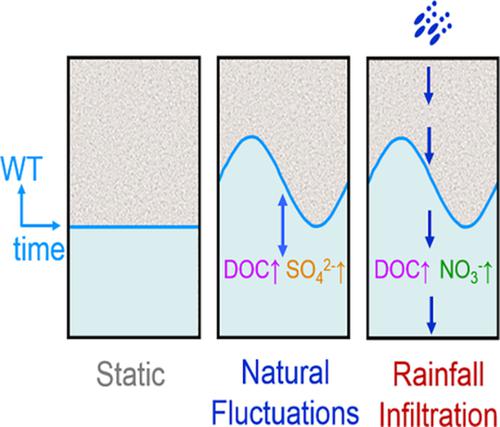当前位置:
X-MOL 学术
›
Hydrol. Process.
›
论文详情
Our official English website, www.x-mol.net, welcomes your
feedback! (Note: you will need to create a separate account there.)
Changes in groundwater bacterial community during cyclic groundwater‐table variations
Hydrological Processes ( IF 2.8 ) Pub Date : 2020-10-12 , DOI: 10.1002/hyp.13917 Xuefeng Xia 1, 2 , Douglas Ian Stewart 3 , Lirong Cheng 1, 2 , Kai Wang 1, 2 , Jing Li 4 , Dan Zhang 5 , Aizhong Ding 1, 2
Hydrological Processes ( IF 2.8 ) Pub Date : 2020-10-12 , DOI: 10.1002/hyp.13917 Xuefeng Xia 1, 2 , Douglas Ian Stewart 3 , Lirong Cheng 1, 2 , Kai Wang 1, 2 , Jing Li 4 , Dan Zhang 5 , Aizhong Ding 1, 2
Affiliation

|
Column experiments containing an aquifer sand were subjected to static and oscillating water tables to investigate the impact of natural fluctuations and rainfall infiltration on the groundwater bacterial community just below the phreatic surface, and its association with the geochemistry. Once the columns were established, the continuously saturated zone was anoxic in all three columns. The rate of soil organic matter (SOM) mineralization was higher when the water table varied cyclically than when it was static due to the greater availability of NO3‐ and SO42‐. Natural fluctuations in the water table resulted in a similar NO3‐ concentration to that observed with a static water table but the cyclic wetting of the intermittently saturated zone resulted in a higher SO42‐ concentration. Rainfall infiltration induced cyclic water‐table variations resulted in a higher NO3‐ concentration than those in the other two columns, and a SO42‐ concentration intermediate between those columns. As rainwater infiltration resulted in slow downward displacement of the groundwater, it is inferred that NO3‐ and SO42‐ were being mobilized from the vadose zone. NO3‐ was mainly released by SOM mineralization (which was enhanced by the infiltration of oxygenated rainwater), but the larger amount of SO42‐ release required a second mechanism (possibly desorption). Different groundwater bacterial communities evolved from initially similar populations due to the different groundwater histories.
中文翻译:

地下水位循环变化过程中地下水细菌群落的变化
包含含水层沙子的柱状实验受到静态和振荡水位的影响,以研究自然波动和降雨入渗对紧邻潜水面以下的地下水细菌群落的影响,及其与地球化学的关联。一旦建立了塔,连续饱和区在所有三个塔中都是缺氧的。由于 NO3- 和 SO42- 的可用性更高,当地下水位周期性变化时,土壤有机质 (SOM) 矿化率高于静态时。地下水位的自然波动导致与静态地下水位观察到的 NO3 浓度相似,但间歇饱和区的循环润湿导致 SO42 浓度更高。降雨入渗引起的周期性地下水位变化导致 NO3 浓度高于其他两列,而 SO42 浓度介于这些列之间。由于雨水入渗导致地下水缓慢向下位移,推测 NO3- 和 SO42- 正在从渗流带迁移。NO3- 主要由 SOM 矿化释放(通过含氧雨水的渗透增强),但大量 SO42- 释放需要第二种机制(可能是解吸)。由于不同的地下水历史,不同的地下水细菌群落从最初相似的种群进化而来。由于雨水入渗导致地下水缓慢向下位移,推测 NO3- 和 SO42- 正在从渗流带迁移。NO3- 主要由 SOM 矿化释放(通过含氧雨水的渗透增强),但大量 SO42- 释放需要第二种机制(可能是解吸)。由于不同的地下水历史,不同的地下水细菌群落从最初相似的种群进化而来。由于雨水入渗导致地下水缓慢向下位移,推测 NO3- 和 SO42- 正在从渗流带迁移。NO3- 主要由 SOM 矿化释放(通过含氧雨水的渗透增强),但大量 SO42- 释放需要第二种机制(可能是解吸)。由于不同的地下水历史,不同的地下水细菌群落从最初相似的种群进化而来。
更新日期:2020-10-12
中文翻译:

地下水位循环变化过程中地下水细菌群落的变化
包含含水层沙子的柱状实验受到静态和振荡水位的影响,以研究自然波动和降雨入渗对紧邻潜水面以下的地下水细菌群落的影响,及其与地球化学的关联。一旦建立了塔,连续饱和区在所有三个塔中都是缺氧的。由于 NO3- 和 SO42- 的可用性更高,当地下水位周期性变化时,土壤有机质 (SOM) 矿化率高于静态时。地下水位的自然波动导致与静态地下水位观察到的 NO3 浓度相似,但间歇饱和区的循环润湿导致 SO42 浓度更高。降雨入渗引起的周期性地下水位变化导致 NO3 浓度高于其他两列,而 SO42 浓度介于这些列之间。由于雨水入渗导致地下水缓慢向下位移,推测 NO3- 和 SO42- 正在从渗流带迁移。NO3- 主要由 SOM 矿化释放(通过含氧雨水的渗透增强),但大量 SO42- 释放需要第二种机制(可能是解吸)。由于不同的地下水历史,不同的地下水细菌群落从最初相似的种群进化而来。由于雨水入渗导致地下水缓慢向下位移,推测 NO3- 和 SO42- 正在从渗流带迁移。NO3- 主要由 SOM 矿化释放(通过含氧雨水的渗透增强),但大量 SO42- 释放需要第二种机制(可能是解吸)。由于不同的地下水历史,不同的地下水细菌群落从最初相似的种群进化而来。由于雨水入渗导致地下水缓慢向下位移,推测 NO3- 和 SO42- 正在从渗流带迁移。NO3- 主要由 SOM 矿化释放(通过含氧雨水的渗透增强),但大量 SO42- 释放需要第二种机制(可能是解吸)。由于不同的地下水历史,不同的地下水细菌群落从最初相似的种群进化而来。











































 京公网安备 11010802027423号
京公网安备 11010802027423号